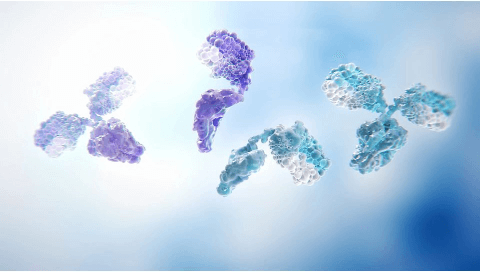Clinical Research & Medicines, Research & Preclinical Development
Two Targets May Be Better Than One
December 02, 2020
How bispecifics are stretching the boundaries of immunotherapy innovation
By: Israel Lowy, MD, PHD, Senior Vice President, Translational and Clinical Sciences, Oncology
Andres Sirulnik, MD, PHD, Senior Vice President, Translational and Clinical Sciences, Hematology

Immunotherapies – such as checkpoint inhibitors and chimeric antigen receptor T-cells (CAR-Ts) – have transformed cancer treatment in the past decade, but the vast majority of patients still do not experience meaningful or durable benefits from these breakthrough therapies. While some may see that as a point of frustration, Regeneron sees it as an open challenge to think outside the box.
Here, Regeneron leaders Andres Sirulnik (blood cancers) and Israel Lowy (solid tumor cancers), discuss why they believe bispecific antibodies (aka bispecifics) may be the next class of medicines to revolutionize cancer treatment and other non-oncologic diseases.
Andres: Monospecific monoclonal antibodies are a cornerstone of care for patients with cancers. While these treatments have undoubtedly helped patients, many cancers are still incurable, and some patients will eventually run out of treatment options. Ultimately, we need better, more innovative approaches and that’s where bispecific antibodies can play a powerful role.
Israel (Izzy): Our research team recognized the extraordinary potential of bispecifics more than a decade ago. Bispecific antibodies bind simultaneously to two different targets, whereas monospecific antibodies can only bind to one target. While other therapies, such as CAR-Ts have shown promise, there are still challenges with the technology today. We certainly recognize the value of these therapies and have even entered into ongoing collaborations, but recognize that generating CAR-Ts is a complex process. The current personalized treatment requires harvesting and expansion of T-cells from a patient, genetic modification, expansion of the modified cells and return to the patient. Treating with CAR-Ts is also complex – it requires the patient to be in good enough health to wait – sometimes several weeks – and be able to have the extensive chemotherapy pre-treatment needed to accept the cells.
Because of these challenges, we decided to focus on creating bispecific therapies – those that could redirect all T-cells to attack a tumor displaying a specific antigen and that have the capability to bind to two different targets at once. Our initial clinical investigation was with CD3 bispecifics, which are unique because of their ability to activate T-cells through the CD3 pathway and bind them to cancer cells.
Andres: Early in development, we realized that not all bispecifics are created equally. We’ve come to believe that our bispecific platform may help overcome profound challenges in cancer treatment. The enhanced potency and selectivity evoked by the bispecific format, combined with how they truly allow us to think outside-the-box to push the limits of drug design is absolutely fascinating.
As Izzy mentioned, bispecifics can bind two targets simultaneously, which creates a drug with novel biology that may not be able to be achieved by simply adding two antibodies together. We have also built our bispecifics to have an elegantly simple design to closely resemble natural human antibodies containing no artificial sequences or linkers. Our hope is that this results in minimizing undesirable immune responses and bestowing them with the pharmacological characteristics of conventional monoclonal antibodies. Our bispecifics are made using standard manufacturing approaches for rapid and efficient production of our medicines.
We’ve initiated several clinical trials for our CD3 bispecific candidates in B-cell malignancies such as multiple myeloma and non-Hodgkin lymphoma (NHL). As these trials continue to progress, we will learn more about the biology of bispecifics and why certain types of cancers are more susceptible, and how the synergy that is created can be combined with additional approaches to continue to improve patient outcomes.
Izzy: It’s encouraging to see the progress we’ve made in blood cancers, however we know that solid tumors have not been as readily treatable and present many challenges: the cells may not be as accessible to treatments, do not express molecules commonly found on blood cancers that may help activate T-cells, and often create tumor microenvironments that limit the immune system’s ability to either recognize or gather enough momentum to control and eradicate the cancer.
Recognizing we needed to do something different, we came up with another type of bispecific: CD28 costimulatory bispecifics. These work similarly to CD3 bispecifics in bridging T-cells to cancer cells, but are designed to enhance T-cell activation via CD28 costimulatory signaling (so called “Signal 2” for T cell activation). We think of them as T-cell booster shots and believe they have the potential to help turn the tide in the immune system’s favor in a variety of solid tumors, including such deadly malignancies as prostate and ovarian cancer.
Andres: What we have discussed today only represents two types of bispecifics; however, we are curating an entire pipeline of medicines that can be combined to create possible therapeutic synergies and transform the treatment of cancer. Our scientists continue to explore novel combination therapies to further improve the depth and durability of antitumor responses in these hard-to-treat cancers. Along with our end-to-end capabilities to leverage our unique technologies and manufacture these therapies, this is what makes our oncology portfolio one of the most exciting in development today.
Our team is looking forward to presenting updated data at this year’s American Society of Hematology (ASH) annual meeting, which will highlight the progress we have made in blood cancers.
These data add to a growing body of evidence solidifying our unique approach to innovative bispecific antibody development and the potential for these therapies to revolutionize cancer treatment for patients. They also reaffirm the progress we are making in bringing our unique expertise to develop medicines for people living with difficult-to-treat cancers across both blood and solid tumors.